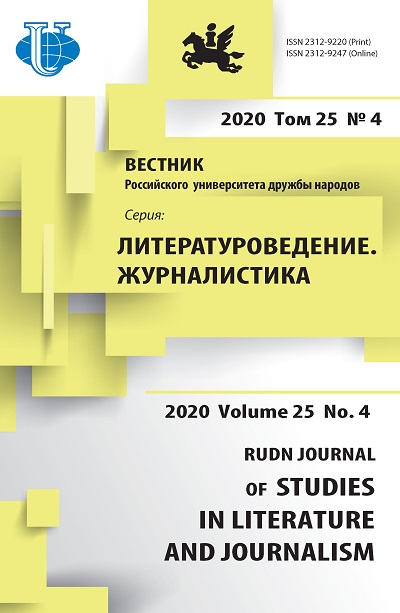Омонимическая и тавтологическая рифма в поэзии К. Симонова
- Авторы: Коржова И.Н.1, Леденёв А.В.1
-
Учреждения:
- Московский государственный университет имени М.В. Ломоносова
- Выпуск: Том 25, № 4 (2020)
- Страницы: 627-638
- Раздел: Литературоведение
- URL: https://journals.rudn.ru/literary-criticism/article/view/25448
- DOI: https://doi.org/10.22363/2312-9220-2020-25-4-627-638
- ID: 25448
Цитировать
Полный текст
Аннотация
В статье исследуются омонимические и тавтологические рифмы как форма языковой игры в поэзии К. Симонова. Изучение рифм в поэзии названного автора, как и обращение в связи с его творчеством к категориям игровой поэтики, осуществляется впервые. Для обозначения частотного у Симонова переходного случая между двумя видами рифм вводится термин «полисемантическая рифма». Выявлена динамика предпочтений рифм и выдвижения их функций на протяжении творчества Симонова. В ранних поэмах он активно обращается к омонимическим рифмам, имеющим характеризующую и миромоделирующую функции. Рифма становится частью более сложной игры и усиливается повторами однокоренных и сходнозвучащих слов, создающих плотную семантическую сетку из важных для Симонова понятий. В зрелом творчестве поэт чаще обращается к полисемантической рифме, а если ставит в позицию конца строки омонимы, то не всегда рифмует их друг с другом. При сохранении прежних функций к ним добавляются традиционная юмористическая и композиционная, связанная с обособлением строк в качестве самостоятельных афоризмов.
Ключевые слова
Об авторах
Инесса Николаевна Коржова
Московский государственный университет имени М.В. Ломоносова
Автор, ответственный за переписку.
Email: clean24@yandex.ru
докторант кафедры истории новейшей русской литературы и современного литературного процесса филологического факультета
Российская Федерация, 119991, Москва, Ленинские горы, д. 1Александр Владимирович Леденёв
Московский государственный университет имени М.В. Ломоносова
Email: aledenev@mail.ru
доктор филологических наук, профессор кафедры истории новейшей русской литературы и современного литературного процесса филологического факультета
Российская Федерация, 119991, Москва, Ленинские горы, д. 1Список литературы
- Лазарев Л.И. Поэзия Константина Симонова // Симонов К.М. Стихотворения и поэмы. Л.: Советский писатель, 1982. С. 5-68.
- Симонов К.М. Стихотворения и поэмы. Л.: Советский писатель, 1982. 623 c.
- Лотман Ю.М. Структура художественного текста. М.: Искусство, 1970. 384 с.
- Гаспаров М.Л. Рифмы омонимические и тавтологические // Известия РАН. Серия литературы и языка. 2011. Т. 70. № 2. С. 44-57.
- Рахимкулова Г.Ф. Языковая игра в прозе Владимира Набокова. К проблеме игрового стиля: автореф. дис.. д-ра филол. наук. Ростов н/Д, 2004. 46 с.
- Корниенко О.А. Игровая поэтика в литературе. Киев: Вид-во НПУ імені М.П. Драгоманова, 2017. 242 с.
- Гридина Т.А. Языковая игра: стереотип и творчество. Екатеринбург: УралГПИ, 1996. 215 с.
- Симонов К. Повесть о трех братьях // Знамя. 1936. № 8. С. 164-168.
- Симонов К. Возвращение // Октябрь. 1937. № 7. С. 140-146.
- Симонов К. Павел Черный. М.: Советский писатель, 1938. 83 с.
- Холшевников В.Е. Основы стиховедения. Русское стихосложение. М.: Академия, 2004. 208 с.
- Жирмунский В. Теория стиха. Л.: Советский писатель, 1975. 664 с.
- Тынянов Ю. Проблемы поэтического языка. Л.: Academia, 1924. 139 с.
- Гаспаров М.Л. Очерки истории русского стиха. М.: Фортуна Лимитед, 2000. 349 с.
- Томашевский Б.В. Стилистика и стихосложение. Л.: Учпедгиз, 1959. 535 с.
Дополнительные файлы















